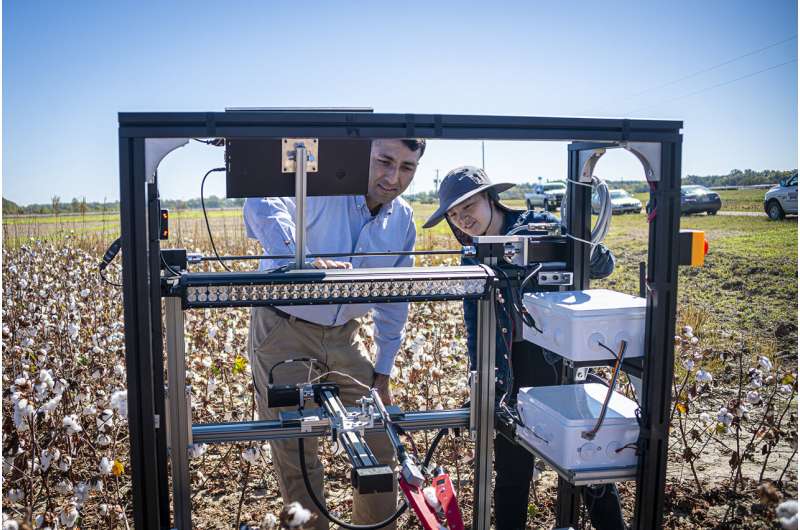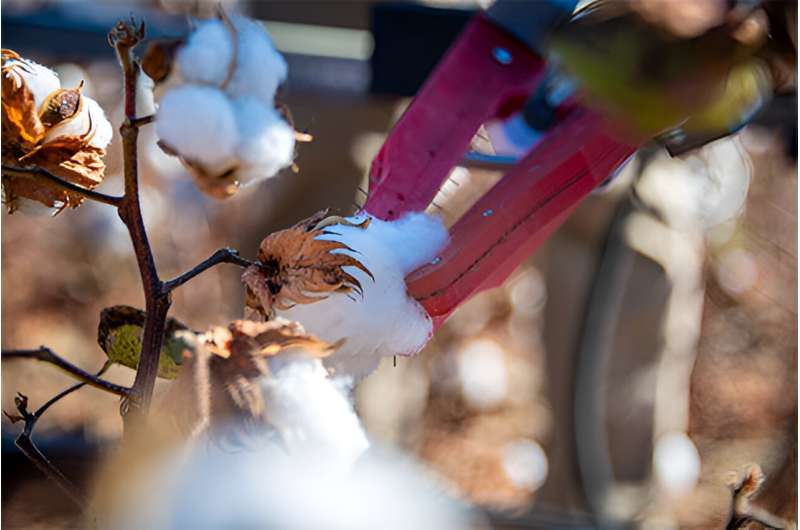This article has been reviewed according to Science X's editorial process and policies. Editors have highlighted the following attributes while ensuring the content's credibility:
fact-checked
trusted source
proofread
'End-effector,' robotic system developed by engineering team puts autonomous cotton harvesting within reach

A two-fingered robotic arm reaches toward a fluffy white cotton boll in a field. The device pulls in the lint from the boll and then moves on…grabbing another, and then another.
This new "end-effector," developed by Mississippi State University scientists, is a potential game-changer for agriculture not just in the Cotton Belt—but worldwide—and could bring the more than $38 billion global industry away from the farm labor shortage to artificial intelligence-based autonomous systems.
"The systems technology we're designing today will give tomorrow's cotton farmers more ecologically and economically sustainable options for harvesting," said Alex Thomasson, MSU agricultural and biological engineering department head who has been a part of the ground-breaking project sponsored by Cotton, Inc.
The research team recently published about the project in the journal Smart Agricultural Technology.
Thomasson said while other universities are involved in this research, it's the MSU-developed end-effector which sets this land-grant university's system apart. The development is among many MSU projects focused on increasing agricultural precision, production and profitability, and the university has formally opened the Agricultural Autonomy Institute, the nation's first and only interdisciplinary research center focused on autonomous technologies to enhance on-farm precision and efficiency.
Experts from the Mississippi Agricultural and Forestry Experiment Station and collaborating entities hope to better feed and clothe the world by combating challenges such as lack of qualified machine operators, soil detriment caused by enormous harvesters and climate change.
Inspired by the distinctive way a lizard's tongue reaches for its prey, the picking device's designer Hussein Gharakhani said the mechanism plucks one cotton boll at a time—rather than all at once like machines—making harvesting possible earlier and more often when seed cotton is at peak quality.
"The cotton plant presents unique challenges to an AI-based camera system because bolls can be oriented in different directions, and seed cotton is not solid and contiguous like an apple," said Gharakhani, an MSU ag and bio engineering assistant professor. "Our end-effector, which took about a year to develop, works with our camera-based perception system to identify and retrieve the fiber from the boll."
Xin Zhang, another investigator and department assistant professor, is focused on integrating Gharakhani's end-effector with a commercial, six-degree-of-freedom robotic arm and a 4-wheel drive robotic platform—the "Husky" made by Clearpath Robotics—which operates with a GPS navigation unit and a perception module.

Central to development of the autonomous harvester is its AI perception module—an RGB-depth-based camera (similar to a smartphone camera), a 3D LiDAR sensor for obstacle avoidance and AI-based processor. Zhang is using Gazebo software, a ROS-based simulator, to replicate the module's performance in a virtual cotton field. She also is currently testing the robot's in-field performance onsite at the university's R. R. Foil Plant Science Research Center, known as North Farm.
"For the last few years, we've been building and testing these systems individually, and over the next year, we'll focus on integration and navigation with the goal of building a completely autonomous harvester that can work across unpredictable and uneven terrain," she said.
Addressing other unpredictable challenges is driving all areas of agriculture to adopt autonomous technology, according to Thomasson, MSU's William B. and Sherry Berry Endowed Chair.
"As the population grows and more people find work in urban areas, fewer people are available for or even interested in farm labor, and it's often difficult to find people who are qualified to operate large agricultural machinery," he said.
In addition, economic and environmental effects of conventional harvesters are incentivizing robotic solutions. Today's six-row, round module harvesters, which gather most of the country's cotton and weigh about 30 tons, can compact soil to the extent fertilizer and water become less effective in the wheel tracks, leading to possible yield reductions. Also, since these machines harvest at season's end, fiber from early-blooming bolls undoubtedly can be lost.
Thomasson acknowledges that this technology has a long way to go to be commercially viable. However, he said robotic systems harvesting research will continue to advance toward sustainable solutions to problems facing agriculture in the decades to come.
More information: Hussein Gharakhani et al, An end-effector for robotic cotton harvesting, Smart Agricultural Technology (2022). DOI: 10.1016/j.atech.2022.100043
Provided by Mississippi State University




















